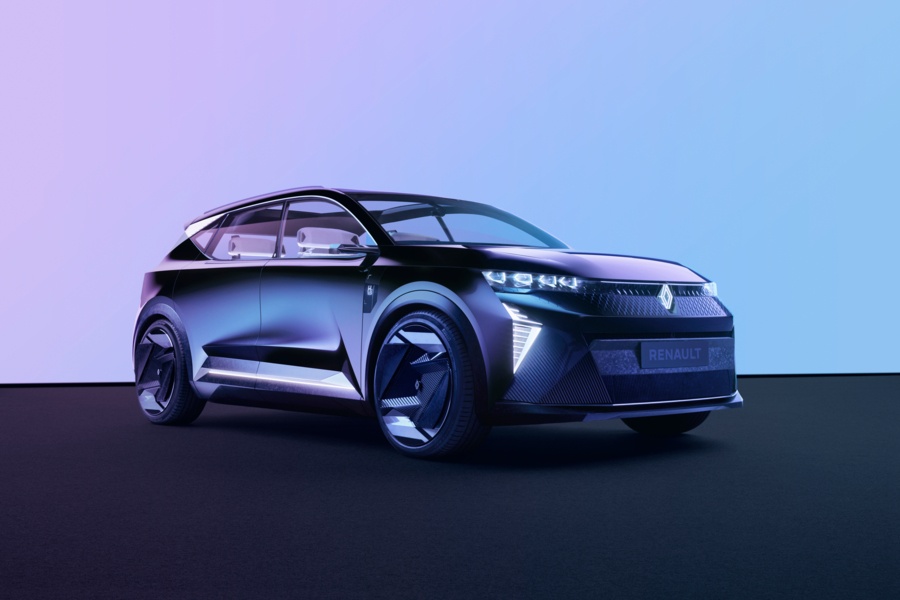Renault presented its Scenic Vision, an electric-hydrogen hybrid concept car that can cover 750 km while enabling charging in five minutes or less. According to the French automobile manufacturer, its hydrogen hybrid engine means it can run on batteries that are twice as light. “This concept prefigures the exterior design of the new Scénic 100% electric model for 2024,” said Gilles Vidal, VP Renault Brand. The 160 kW electrically excited synchronous motor is at the rear, the 2.5 kg hydrogen tank at the front, while the 16 kW fuel cell is under the floor, at the back of the platform, behind the 40 kWh battery. The car measures 4,490 mm x 1,900 mm x 2,835 mm and weighs in at 1,700 kg. “The H2-Tech technology is based on the ‘range extender' technology, which makes it possible to carry a battery that is twice as light, for the same range, thus contributing to decarbonization beyond the electrification of the vehicle,” the manufacturer said. “In 2030 and beyond, once the network of hydrogen stations is large enough, you will be able to drive up to 800 km – or, for instance, 750 km from Paris to Marseille – without stopping to charge the battery. You will only have to stop for 5 minutes or less to fill the hydrogen tank.”
Japan's Shinshu University researchers have developed a graphene-wrapped molecular-sieving membrane to increase permeation speed, allowing a decrease in the pressure applied and the related energy needs. According to the study recently published in Science Advances, the membrane has a separation factor of 245 and a permeation coefficient of 5.8 x 106 barrers. Graphene is wrapped around the MFI-type zeolite crystal. “This separation membrane separates hydrogen at a speed of about 100 times while maintaining a higher separation coefficient than conventional separation membranes,” wrote the researchers.
Toho Gas will build a hydrogen production plant using natural gas at Japan's Chita Midorihama Plant. As a first step, the company will build a plant with a hydrogen production capacity of 1.7 tons/day by 2024. “After that, we will expand the scale of the plant in line with the expansion of hydrogen demand in this region,” the Japanese gas distributor wrote, adding it is looking for collaboration with other companies to build the entire hydrogen supply chain.
Topsoe announced it would construct a new Solid Oxide Electrolyzer Cells (SOEC) electrolyzer production plant in Herning, Denmark. The 500 MW plant, scalable up to 5 GW, should be operational by 2024. “Construction is scheduled to begin in the second half of this year, subject to Board and other regulatory approvals,” the Danish engineering group wrote on Monday, calling it the “world's largest electrolyzer production facility.”
The International Atomic Energy Agency (IAEA) launched an initiative to develop a roadmap for the commercial deployment of hydrogen production using nuclear energy. The initiative will lead to a roadmap guiding document to provide countries with a tool for evaluating, planning, and strategizing the development of nuclear hydrogen projects. According to Francesco Ganda, the IAEA Technical Lead for Non-Electric Applications, hydrogen production powered by heat from advanced technologies such as high-temperature gas-cooled reactors (HTGRs) is highly competitive in current price scenarios. “HTGRs are under development in several countries, and prototypes are already operating in China and Japan,” said Ganda.
Shell Brazil and the Port of Açu signed a Memorandum of Understanding (MoU) for the joint development of a pilot plant to generate green hydrogen at the port facilities located in the northern region of the state of Rio de Janeiro. Shell Brazil should invest between US$60 million and $120 million in RD&I in 2022.
bp has announced the participation of energy companies from the United Arab Emirates in its developments in Teesside in the northeast of England. ADNOC, the UAE's largest energy company, will take a 25% stake in the design stage of the blue hydrogen project, while the renewable energy company Masdar will take a stake in the green hydrogen project.
This content is protected by copyright and may not be reused. If you want to cooperate with us and would like to reuse some of our content, please contact: editors@pv-magazine.com.


“We think it’s just not going to happen without hydrogen. It will be really helpful for transport, for storage, and for other different applications.”
Exactly, Karsten Wilbrand.
So why are we making it a two-step solution (battery, then hydrogen) when we could go directly to hydrogen and get there faster. If time is of the essence in climate change, why are we spending the limited time and resources that we have on fast chargers — all of which will become obsolete when hydrogen takes off exponentially.
Hydrogen will likely never over take battery EVs as hydrogen will always be more expensive due to extra losses (when converting to hydrogen then back to electricity) and will mean more generationis needed. Heavy machinery, shipping, aircraft and this (range extending electric vehicles) makes more sense. Also in the article it stated hydrogen made from gas, many studies have shown that this would actually create more CO2 than just burning the gas so there is no point. Green (renewable) hydrogen is the only hydrogen that makes sense.
A hydrogen hybrid with electric and hydrogen charging offers most flexibility and efficiency. Most of the time drivers will be able to run in grid power but have the hydrogen as the option for long distance/ touring driving.